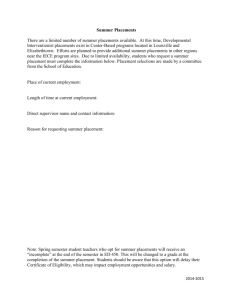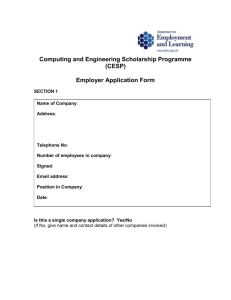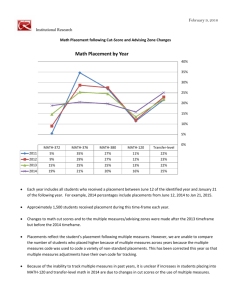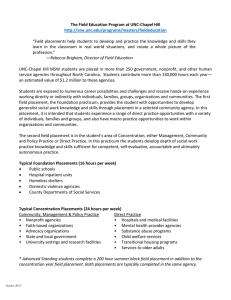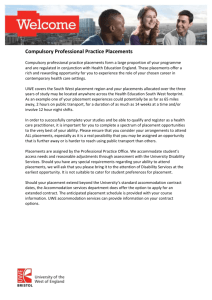Guide to examples of good quality STEM placements
advertisement
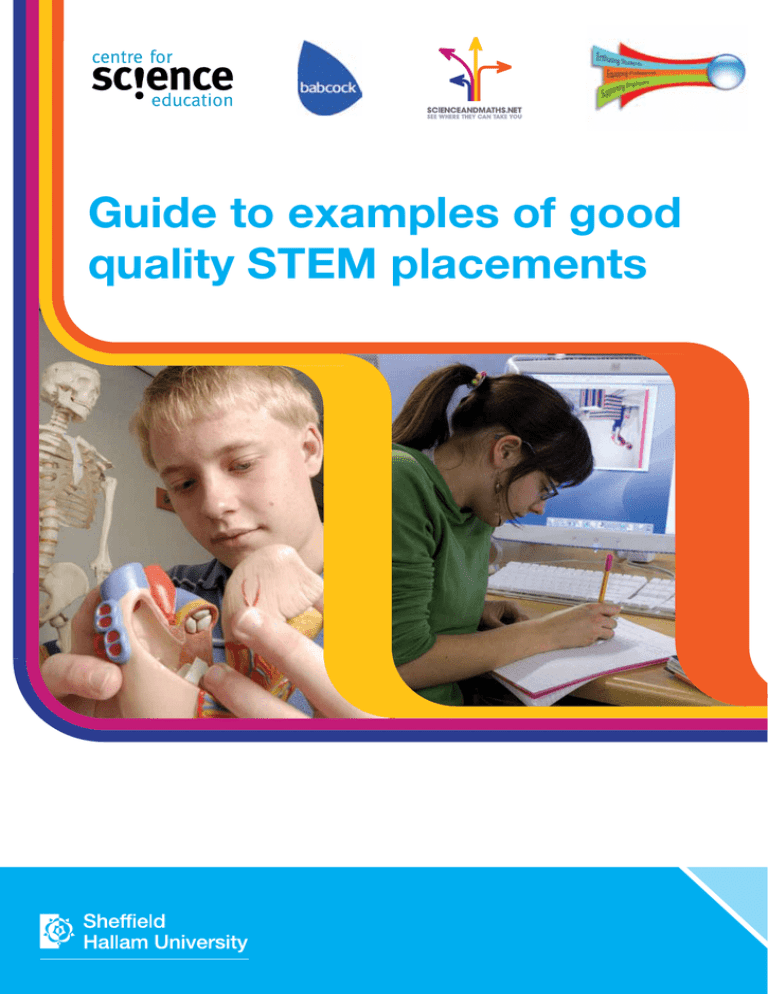
Guide to examples of good
quality STEM placements
CONTENTS
Introduction to this resource
3
Mott MacDonald
4
Royal Air Force
5
JNP Group
6
Connaught plc
8
Ardagh Glass
9
Industrial Software Limited
10
Programming a PLC to a train track (example of project)
11
JRI
13
Wider Horizons sample programme
14
Acknowledgements and Further Information
15
In addition to this guide, further information may be found in the ‘Quick Guide for STEM Work Experience
Placements’ and the Teachers TV Programme about STEM Subject Choice and Careers Role Models and Work
Placements, available at:
http://www.nationalstemcentre.org.uk/elibrary/resource/1622/quick-guide-for-stem-work-experience-placements
http://www.teachers.tv/videos/stem-subject-choice-and-careers-role-models-and-work-placements
This guide has been developed through the STEM Subject Choice and
Careers Project. It is designed to help employers, teachers, students and
anyone involved in work experience develop strategies for creating good
quality placements for young people aged 14–19. The guide can be used in
conjunction with the Quick Guide for STEM Work Experience Placements
which was produced in 2010 to give an overview of factors to consider when
organising and offering work experience.
This guide contains examples of good practice which are intended to reflect a range of different placement type in
small and medium enterprises, public sector organisations, large corporate environments and in a variety of STEMrelated work experience. There are many examples of inclusive and exciting placements linked to STEM subjects
which we have not had the opportunity to investigate further and include. Some of these can be accessed through
the websites listed at the end of this publication. Themes included in this guide often reflect practice which is
promoted by education business partnerships and other organisations, and efforts have been made to select
examples which are relevant to STEM as well as highlighting equality and diversity.
The examples we have cited are all slightly different but include the following common themes which reflect good
practice in any work placement, regardless of whether it is STEM based or not.
•
having a named contact who is responsible for co-ordinating the placement
•
ensuring that there is a named contact for the duration of the work experience
•
providing a structured programme where the learner and the staff of the organisation know what is expected
of them
•
including a project or workbook which helps the young person identify what they have learned
•
offering practical ‘hands-on’ activities within the bounds of health and safety
•
building in some form of feedback so that the learner and the employer have an opportunity to highlight the
positives and make recommendations for change
Some of the companies included in the guide were involved in the Wider Horizons, which was created to encourage
more females into STEM related work experience activities. A sample programme was created for employers at that
time and proved to be very popular. A copy has been included at the end of this guide.
All of the companies listed in this booklet have completed health and safety risk assessments administered either
through their own systems and/or through the local work experience provider network.
For further information about these and other examples of positive STEM related work experience placements please
contact: Jill Collins at the Centre for Science Education, Sheffield Hallam University (wiset@shu.ac.uk)
3
Mott MacDonald
Mott MacDonald is a leading global management, engineering and development consultancy that has more than
14,000 staff and works in 140 countries. In the UK, the consultancy has developed a programme of work experience
which encompasses different areas of its business as well as enabling the placement student to complete a focused
technical project. The aim is to provide students with an opportunity to apply and develop their knowledge via
practice and provide an experience that would allow them to make informed decisions on both subjects for study
at a higher level and on their future career path.
Created with the flexibility to allow students aged between 14-19 to complete, the project pack has been developed
to accommodate varying levels of ability and confidence.
Key features of the Mott MacDonald programme include:
•
Learning outcomes of the placement are negotiated with the young person so that they know what they can
expect on arrival. •
Allocation of a “buddy” who ensures that staff are briefed and a structured programme is in place before the
student arrives
•
The student is given a project to complete which introduces them to the core business of the company and
includes some hands-on activities such as computer aided design (CAD)
•
Ensuring that the terminology used in the materials given to the student are easy to understand and allows
them to learn about new processes and business language. •
The activities are linked to employability competences, for example – communications and IT which students
are encouraged to consider when updating their CV on their return to school
•
Targets for students are set at the beginning and reviewed at the end of the placement
•
A presentation at the end of the week allows the staff to review what has taken place and help the student
identify what they can do to build on the experience (e.g. find out more about engineering, update their CV
regularly)
•
Staff are aware of the benefits of providing a positive placement for the company and for themselves; it
contributes to their own career and personal development as well as the company’s Corporate Responsibility
contribution and can be used as evidence in bidding processes
For more about Mott MacDonald go to www.mottmac.com
4
Royal Air Force (RAF)
The RAF has developed a range of initiatives aimed at encouraging applications from a broader pool into all
trades and professions. In the STEM arena there are particular programmes which the RAF has engaged in and one
example is the work experience residential weeks for young women, these have been offered at RAF Cosford and
the programme was developed with support from WISE and the UKRC (UK Resource Centre for Women in Science,
Engineering and Technology). The programme has been adapted for delivery with boys from under-represented
backgrounds and with girls who take part in a week focused on logistics activities. They were delivered at RAF
Cranwell and RAF Halton respectively.
The RAF approach has been one where management commitment to the delivery of bespoke programmes for ‘girls
into engineering’ was initially gained, to highlight the fact that more could be done to increase the number of
applications for STEM roles. Gender equality training was initially delivered to senior managers at RAF Cranwell and
then with instructors at RAF Cosford. This was aimed at highlighting how activities could be adjusted and involve
more hands-on participation in an exciting and engaging way. Consultants from WISE and the UKRC supported the
RAF team in identifying how areas of the programme could be made more participative so that girls had the
opportunity to experience practical activities like removing an aircraft wing and wiring a test board. A workbook was
written to tell them what they would be doing each day and help them identify the skills learned and how they might
use them in their career planning.
At the end of the week’s experience the families and teachers of the participants were invited to attend a celebration
event where the girls presented PowerPoint slides outlining what they had learned. The individuals who undertook
the engineering and logistics experiences also gained CREST awards which were presented at the event.
Key features of the RAF programme included
•
ensuring that trainers coming into contact with the girls were aware of the programme and how their input
could affect their future career choices
•
linking up with nationally recognised organisations like WISE, UKRC, the Girls’ Venture Air Corps and
Generating Genius for advice and support
•
providing a bespoke workbook which included career planning materials and information about what
the learners would be doing each day plus a diary to record their thoughts
•
a celebration event where families and teachers could find out more about what the girls learned during
the week
•
showcasing the programme throughout the organisation and in broader networks to ensure that clear
messages about the RAF’s commitment to encouraging a wider range of applications is clear
Websites:
www.raf.mod.uk/altitude
www.wisecampaign.org.uk/parents_and_teachers/work_experience.cfm
5
JNP Group
JNP is a consulting engineering company with offices around the UK. Staff at the Sheffield office have
developed a programme aimed at ensuring that learners have a broad experience which includes some
technical skills. The company is committed to ensuring that young people on placements with them have as
much opportunity to undertake practical activities as possible and manage their time effectively in order to do this.
A staff member has been given responsibility for organising and supervising the placements. He has devised a list
of work experience training tasks which is used as a template for providing a young person with a varied and
relevant programme of activities.
A feature of the JNP approach which are particularly worthy of note are the commitment of a senior manager to
delivery of a good quality placement which he has delegated to a more junior staff member in order to give him the
opportunity to develop supervisory skills. There is nothing haphazard about the placements organised at JNP, staff
on site are clear about the lines of responsibility and the need to ensure that the learner has all the information she or
he needs to complete the activities.
When possible, and within the confines of health and safety regulations, learners are taken on site visits to observe
how the office based activities such as computer aided design (CAD) have an impact on company projects.
The work experience training tasks are
1)
Induction forms, timesheet, PC system and intranet
2)
CAD training – City & Guilds workbook
3)
Paper bridge task – research bridge design and then build your own
4)
Loading down on a house – work out wall line loads
• use a list of material weights
• house layouts and elevations
• work out the line loads for each wall
5)
Pile and ground beam House – design foundations for a house
• draft up the pile and ground beams for the house in task 4
• use the line loads obtained to work out the pile loads
6)
Reinforced concrete – Simple RC detailing
• create a RC drawing for the ground beams
• create a bar bending schedule
• do it by hand at first then CAD it up
7)
6
Surveying – Use of level in car park, or on site if there is anyone going (Stephen Burrows is our
resident expert)
8)
Geotechnics – examine the history of a site and its surroundings to determine site conditions and risks
from pollution, flooding and past mining.
• Using an existing envirocheck report
• examine the historical maps
• find out the geology using the BGS map
• use the Environmental Agency website for flood Maps
• use Google for a decent ariel photo
9)
Cut and fill exercise
10) Topographical sections
• create section drawings using topographical level information (good CAD task as well)
11) Steel frame drawing using engineers calcsheets create a steel frame ‘stick’ drawing
12) Straw skyscraper task
13) Drainage levels – run through drainage layouts and details and put levels on an existing project.
14) Quantity surveying task – scale rule and calculator required
15) Travel plan task – maps of Sheffield required – use internet for up-to-date versions
16) Beam design task
17) Flood risk assessment task
Website:
www.jnpgroup.co.uk
7
Connaught plc
Connaught plc developed a work experience programme which was a shining example of how the whole company
could benefit from engagement with young people. At the heart of the work programme was a commitment to involve
a diverse range of individuals, both as ambassadors for the company and as participants of the scheme.
Initially the company suspended all work experience placements nationally as it recognised that the programme
needed overhauling to improve its quality. A project team was established, consisting of personnel from several
areas of the business plus some external education specialists. They included an adviser from Nottingham
Education Business Alliance – the local education business partnership – and a co-ordinator from the UKRC
which aims to encourage more women into STEM.
The project team agreed the following principles which were integral to the future success of the programme.
•
to create a standard work experience programme and process that can be used as a model to roll out across
the company
•
to challenge stereotypes by designing a programme that incorporates and develops a wide variety of skills –
such as customer services and quantity surveying – as well as the trade skills. Insisting that the schools
promoted the placement to a more diverse set of learners.
•
to ensure health and safety and child protection obligations were met
•
to establish an internal staff development opportunity by creating a senior work experience ambassador
and a work experience ambassador role
•
to work with a small number of dedicated schools. These schools were The Dukeries School in Newark,
a specialist construction school, and Quarrydale school in Sutton in Ashfield. Both were in the partnership
works community.
•
to run a pilot programme before going live, to provide a platform offering the greatest chance of
achieving excellence
•
to ensure that the students had a realistic experience to build their employability skills, including an application
and interview process for the placement students
When the programme was rolled out it was built around a programme of engagement with local schools which
reflected the customer base of the company. Connaught worked with the schools in a very pragmatic way by
offering assemblies and hands-on activities such as tiling. They advertised work experience placements through
a poster and application process which mirrored a real job application process and asked the schools to encourage
applications from girls as well as boys.
Other key features of the programme were
•
advertising within the company and recruiting work experience ambassadors to organise and
supervise placements
•
training ambassadors in recruitment and selection, health and safety and dignity at work, and through
the STEM Ambassador Network which includes CRB checks and how to work effectively in schools
•
ensuring that placements were offered to equal numbers of boys and girls in each region
•
staying in touch with learners after the experience and tracking through to apprenticeships
Connaught plc went into administration in 2010
8
Ardagh Glass
Ardagh Glass is a global glass manufacturing company and supplies many of the world’s largest food and beverage
brands. The company employs around 6,500 people and produces in the region of 13 billion glass containers a year.
During the Wider Horizons project in South Yorkshire the Doncaster site hosted a placement aimed at encouraging
more females into science, engineering and technology, where they are currently under-represented. The Doncaster
plant is typical of many manufacturing companies and the technical and engineering areas where there is a
predominantly white male workforce, the majority of who are over 40. Wider Horizons placements were aimed at
encouraging girls who had opted for traditionally female work experience, such as administration, to try something
new linked to science engineering and technology.
Health and safety is always a key factor in organising a work experience placement and it was clear from the outset
that the learner would not be able to work in certain areas of production, particularly at the ‘hot end’. The company
was keen to ensure that the placement participant could undertake a project, and they asked her to complete an
analysis of the existing workforce by gender, ethnicity and age.
Throughout the two week period she spent time based in the Human Resources Department, supervised by one
of the women in the team. However she also completed tasks within the store’s department, with the engineering
technicians, in the ‘cold end’ and in other areas of the company. At the end of the placement the student presented
her findings regarding the profile of the workforce to the HR team which included the following statements
•
I learnt about the different roles of the different employees
•
I learnt that I don’t want to be an electrical engineer
•
I learnt that I don’t mind the heat, grime and dirt of the shop floor
•
I learnt that there are very few females in engineering jobs
•
I learnt that I would consider becoming an engineer as one of my possible career options
Key features of this placement were
•
allocating one member of staff responsible for the day-to-day management of the student
•
completing a project during the two week period
•
presenting the project
•
spending time in various departments to gain an overview of the organisation
•
a commitment by the HR department to offer more placements which encourage females to find out more
about engineering and technical roles
Website:
www.ardaghglass.com
9
Industrial Software Limited
The company develops software for industrial applications and employs about 12 people. The company has two
directors who share management responsibilities. One is a woman who is an engineering consultant and advisor in
a college nearby and takes the opportunity to act as a positive role model for girls thinking about engineering and
ICT careers. Work experience is offered through local schools and colleges. The company has hosted mainly male
learners and would welcome more applications from females.
The activities developed for learners on placements at Industrial Software are technical in nature and the job
description given to learners is very clear about this. An excerpt from the job description is contained below.
Website:
www.industrialsoftwareltd.co.uk
Work Placement – Junior Design Engineer
The Company:
Industrial Software Ltd is a fast growing company specialising in providing industrial systems application software
to both blue chip and smaller clients. This includes the design, installation and commissioning of control systems
software ranging from pharmaceutical manufacturing plants to rollercoasters.
Job Description:
The candidate will be part of the engineering team and will be given basic programming tasks to help the team meet
project deadlines. It is essential that the candidate have the ability to integrate well with the team as well as being
self-motivated and willing to expand their knowledge.
Duties will include (dependent upon the project timeline):
•
Introduction to basic control systems and an overview of the types of software that Industrial Sofware produce
and the hardware utilised (ie PLCs - Programmable Logic Controllers, HMIs - Human Machine Interfaces,
SCADA - Supervisory Control & Data Acquisition).
•
Help produce software design manuals and test procedures.
•
Spreadsheet data entry.
•
Produce basic HMI/SCADA graphics. The graphics represent the ‘shop floor’ process that is controlled and
monitored by the control system software.
•
There may be the opportunity to visit a site where a control system is being installed and commissioned
(at customer discretion). If allowable this would be with a senior ISL engineer and the candidate will be
‘shadowing’ to see first hand how a control system is commissioned, the candidate will not be operating
any controls.
The following is a project which a young person at the end of their work
experience placement at ISL.
10
Programming a PLC to a Train Track
PLC
Switches
Train
Track
Power
I have programmed a Mitsubishi PLC by using Melsoft GX Developer to make a train on a track move by just flicking
switches, firstly, I programmed the PLC to make the train move when both of the 2 switches were on. Displayed by
the picture of the first program shows 2 switches open (X0 and X1) and at the end of the line there is the ‘Train Power’
(Y0). The train would only move if both of the switches were connected, if X0 was on but X1 wasn’t, it wouldn’t work,
so both switches would have to be on for the train to move, because there is only one line for the power to the train
to move on, there is no other possible way for the power to get round and open switch.
12
X000
15
X001
{Y000
}
[END
]
I have programmed a Mitsubishi PLC by using Melsoft GX Developer to make a train on a track to move by presses
either of the switches, so only one switch needs to be pressed down for the train to move around the track. As shown
on the picture below, there are 2 switches, one under another, so if the bottom switch is turned on, it will go around
the first switch and go straight to ‘Train Power’ same with the same switch, it will miss the bottom switch and go
straight to the ‘Train Power’.
12
X000
{Y000
}
X001
11
Switches
Power
12
X000
X001
15
{Y000
}
[END
]
I have programmed a Mitsubishi PLC by using Melsoft GX Developer to make a train on a track to move by having
both of the 2 switches off at the same time and no switches on. This works just like the first one but with different
contacts, the first 2 contacts were switches with nothing between, but the picture below shows the different contacts
used for a different purpose.
To make sure that all of the circuits worked, I used something called a ‘Truth Table’ on the last PLC that I
programmed which gives me a certain amount of tests to take out which usually only 4 with the tables above.
1
1
0
X1
X0
Y0
0
0
1
0
1
0
1
0
0
PLC
(Programmable Logic
Controller)
Programming
Cable
Train
12
JRI Ltd
Joint Replacement Instrumentation Limited is a British manufacturer of orthopaedic implants and surgical
instrumentation (including replacement hip, knee and other joints). Operating from it’s Sheffield base JRI is a leading
manufacturer and supplier of innovative products designed to meet the challenges of joint repair and replacement.
JRI has a history of offering varied work experience placements which offers learners an opportunity to find out about
different roles in a number of departments. An example of the programme is shown below.
Itinerary for Work Experience Student
Date
Department and Activity
Monday 22nd June
Morning
Science Exam at School.
Introductions and Inductions inc H&S
DD/DN/MJ/AT
Afternoon
Continue above – Technical Projects overview
AC/AK
Morning
Maths Exam at School.
Quality Department – administration, training,
suppliers, visual standards, Library, records,
document control, calibration
SD/MB/AK
Afternoon
Quality Department continued – complaints, NCs,
standards, regulation/legal, MHO training
BS/DN/DD
Morning
Design Department – general housekeeping and
introduction to design activities
MB/JT
Afternoon
Continue design activities (2D CAD work and
introduction to 3D).
MB/JT
Morning
Ceramic Department – supervised activities
IH
Afternoon
continue in Ceramic Department
Morning
Customer Service and Dispatch – supervised
activities and general housekeeping
Afternoon
Continue in CS & D
Morning
Metrology – general overview – supervised use of
some testing equipment if possible
Afternoon
Continue in Metrology
Morning
Cleanroom access and supervised activities
Afternoon
Continue in Cleanroom
Morning
Goods Inwards and Stores
Afternoon
Continue in Goods Inwards and Stores
Morning
Shop Floor – production in cup/head cell,
supervised use of some programmes (e.g. blasting
for instance?)
Afternoon
Shop Floor – other cell activities – e.g. Plastics
time/activities permitting or time in Polishing
Morning
Production Scheduling, Control & Engineering
– introduction and activities
JS
Afternoon
Continue in Production Office – close out plenary
AM/CB/PS/JP
Tuesday 23rd June
Wednesday 24th June
Thursday 25th June
Friday 26th June
Monday 29th June
Tuesday 30th June
Wednesday 1st July
Thursday 2nd July
Friday 3rd July
Person(s)
DR/HK
SJ/JT
LS
IP/JM
CO/PB/SF
Website:
jri-ltd.co.uk
13
Sample Wider Horizons programme
A Baldwin & Co
Morning Activity
Staff
Member
Afternoon Activity
Staff
Member
Mon
Induction & Health & Safety
briefing
Martin Hill
Observe reception area
Receptionists
Tues
Accounts Department
Accounts
team
Contracts Department
Contracts
Manager
Visit various worksites
Tenant
Liaison
Officer
As per morning - with Tenant Liaison
Officer
TLO
General Office Duties
Finance &
Admin team
Continue in general office - can
spend time on workbooks
Finance &
Admin team
Fri
Visit Depot/s (Wortley/Hunslet) to
observe work planning,
maintenance/social housing
contacts
Martin Hill
As per morning
Mon
Meet Marketing Team to discuss
powerpoint
Ian
Meet Holly, plumber
Tues
Visits with Site Supervisor
Site
Supervisor
As per morning
General Office Duties
Finance &
Admin team
Continue in general office - can
spend time on workbooks
Visit other departments Engineering, Joinery, Plastics,
Glass, etc
Department
Managers
Free time for student to revisit any
departments or plan activities she is
interested in.
Marketing team for support with
powerpoint presentation
Marketing
team
Finalise powerpoint slides and meet
with Martin Hill for debrief
Fri
Holly
Finance &
Admin team
Martin Hill
Notes
•
The student can use spare time to complete elements of the two workbooks she will be issued with.
•
If alternative activities arise during the fortnight (eg a presentation by the marketing department) then the
timings may need to be adjusted to accommodate this - it is important that the experience is varied and
interesting and the schedule can be flexible to reflect this.
•
The student will be asked to prepare a powerpoint slide show which they will present to parents, pupils &
staff on their return to school from the placement. It would be ideal if a member of the marketing team (or
someone with experience of preparing presentations) could support the student in this activity. The student
will be issued with a disposable camera to collect photographic evidence of activities.
•
Any other female role models in non-traditional roles could be introduced to the student as appropriate
(eg outside contractors on site - particularly professional/technical level).
•
If this format is not practical for operational or staffing reasons it can be adapted and is only intended
as a guideline.
Executive summary for Wider Horizons are available at:
www.wiset.org.uk/index.php?mact=News,cntnt01,detail,0&cntnt01articleid=63&cntnt01returnid=26
14
Acknowledgements and further information
Kathryn Close, Mott MacDonald
Squadron Leader Glyn Dean, RAF
Derek Smith & Stephen Burrows, JNP Group
David Hinchley-Robson, Connaught plc
Melvin Pyle, Ardagh Glass
Zoe Cooper, Industrial Software Ltd
Paul Stocks, JRI Ltd
Further information about work experience placements
can be found in the following.
For further information about these and other examples of positive STEM related work experience placements
please contact: Jill Collins at the Centre for Science Education, Sheffield Hallam University (wiset@shu.ac.uk)
A Quick Guide for STEM Work Experience Placements – available at www.nationalstemcentre.org.uk/elibrary/
collection/207/stem-subject-choice-and-careers
www.rsc.org/Education/SchoolStudents/careers.asp – careers pages from the Royal Society of Chemistry,
including pages on work experience placements.
www.britishscienceassociation.org/crest – gives information on the different levels of CREST awards and how
they can be achieved.
http://www.hse.gov.uk/youngpeople/workexperience/placeprovide.htm – specific information for work experience
placement providers.
www.nhscareers.nhs.uk/workexperience.shtml – a page on the NHS careers website where the downloadable
pdf version of the work experience pack is available with useful mythbuster page and information other organisations
may find useful.
www.direct.gov.uk/en/EducationAndLearning/14To19/Years10And11/DG_10013569 – government website
containing useful guidance about work placements and links to other sites. Aimed mainly at young people.
www.iebe.org.uk/index.php/business – the Institute for Business Excellence was launched in June 2009 and
brings together individuals and organisations working in the space between education and business.
http://www.employers-guide.org/ – The Employers’ Guide has been designed to help employers of all types and
sizes to work more closely with schools and colleges.
http://www.education.gov.uk/publications/standard/publicationdetail/page1/DFES-1471-2005 – This booklet offers
general guidance and practical advice on the main issues relating to work experience placements for students in their
last two years of compulsory schooling.
http://www.cbi.org.uk/pdf/timewellspentbrief.pdf – “Employabilty and work experience: a quick guide for employers
and students” outlines the competencies that make someone employable and ideas for employers on how to
improve development of employability during work experience
www2.warwick.ac.uk/fac/soc/cei – the Centre for Education and Industry is involved in research and teaching
in work related learning, vocational education and training, and enterprise education.
Centre for Science Education Sheffield Hallam University
City Campus
Howard Street
Sheffield S1 1WB
Phone 0114 225 4870
Fax 0114 225 4872
A Department for Education initiative to promote subject choice and careers in Science, Technology,
Engineering and Maths (STEM) delivered by the Centre for Science Education at Sheffield Hallam
University and Babcock
Crown Copyright 2011
Extracts from this document may be reproduced for non-commercial research, education or training
purposes on the condition that the source is acknowledged. For any other use please contact
hmsolicensing@opsi.x.gsi.gov.uk
www.shu.ac.uk/cse
2203-02/11
